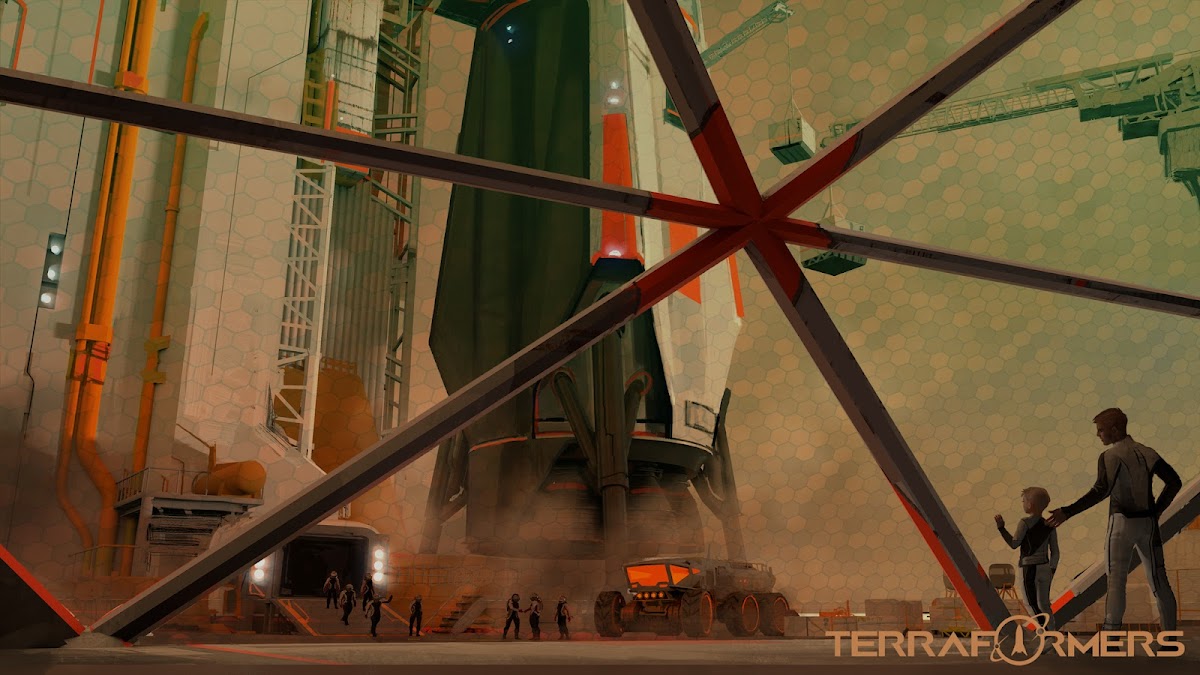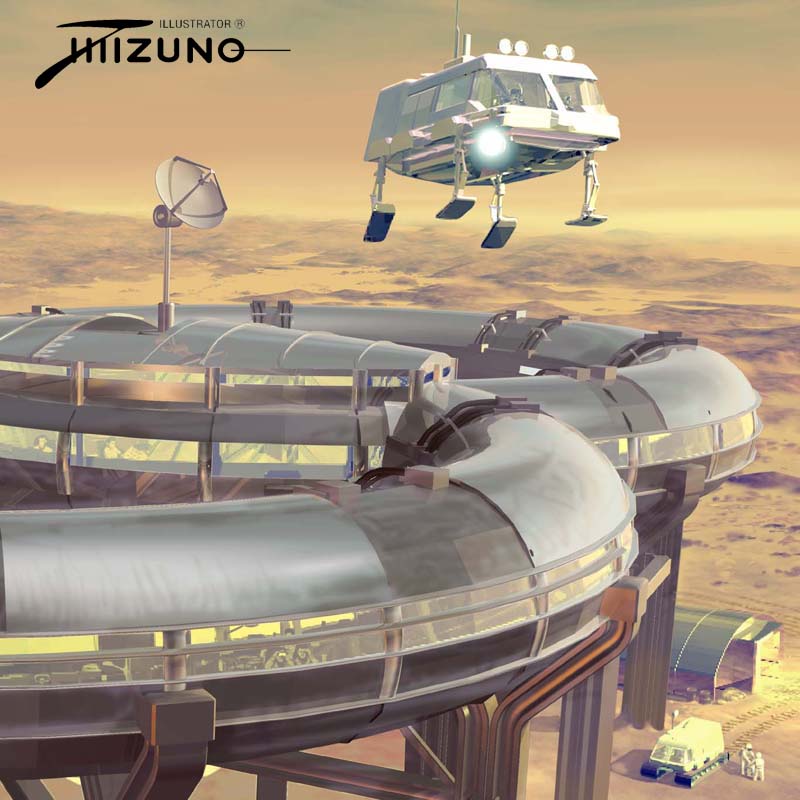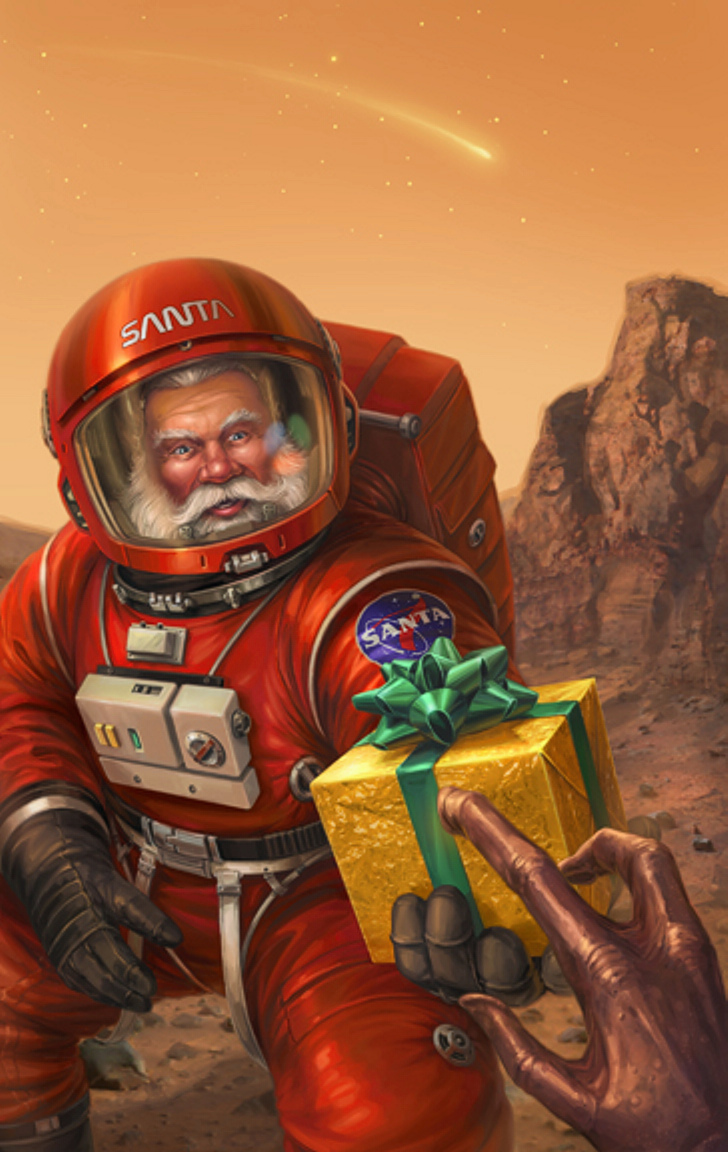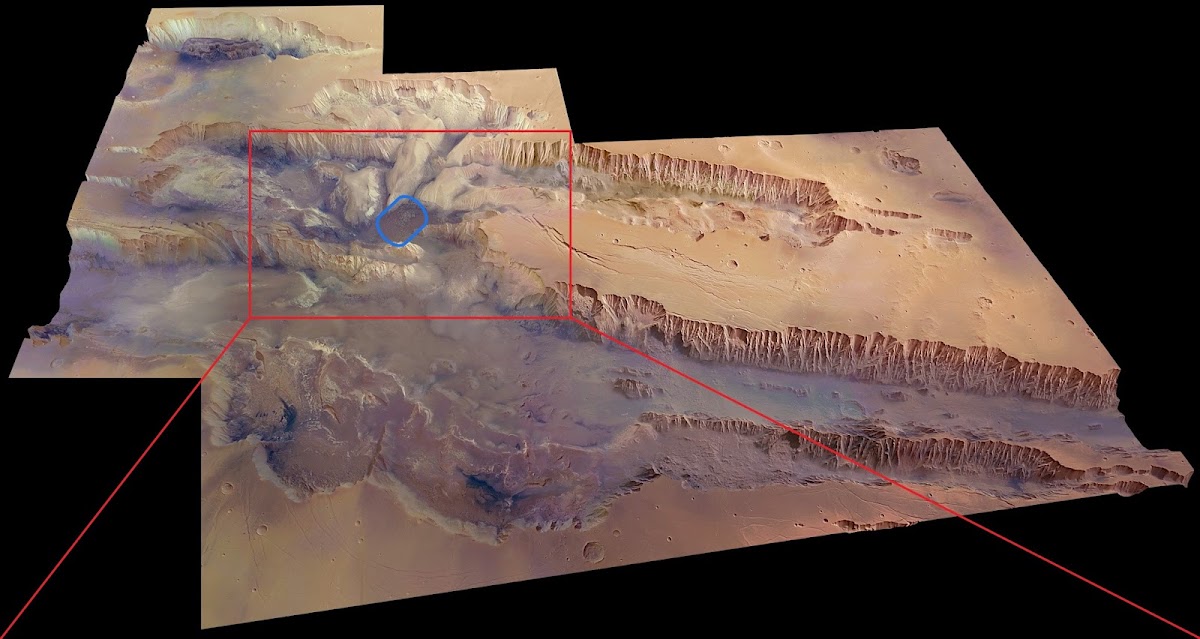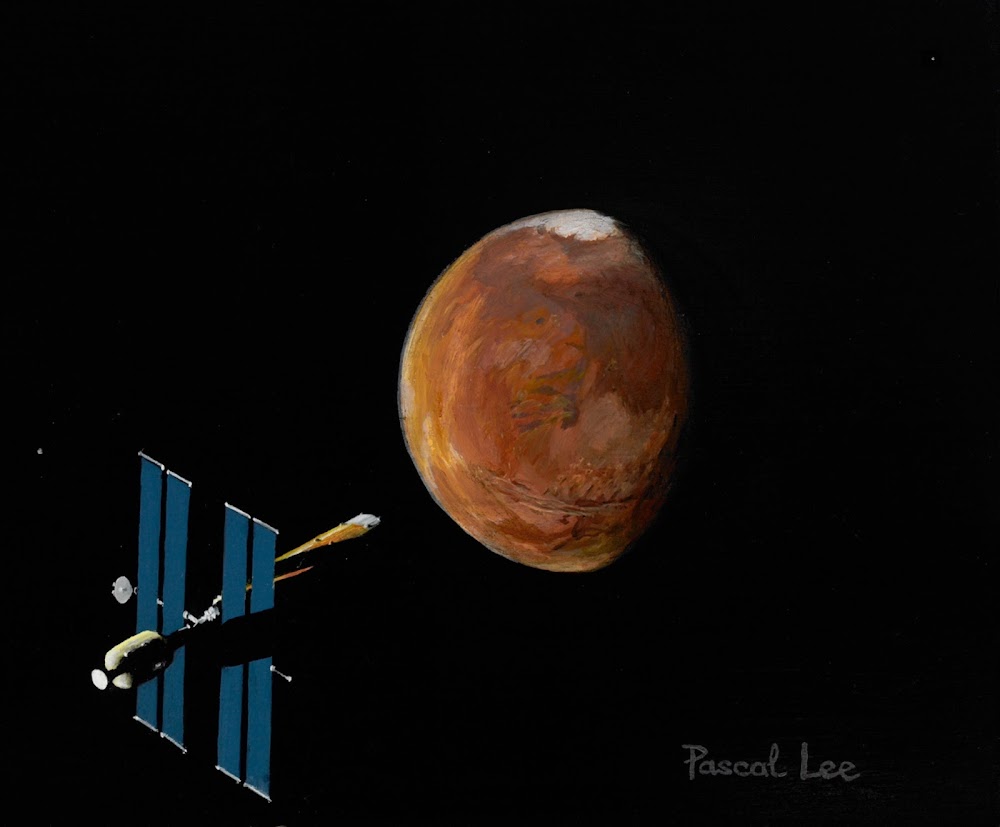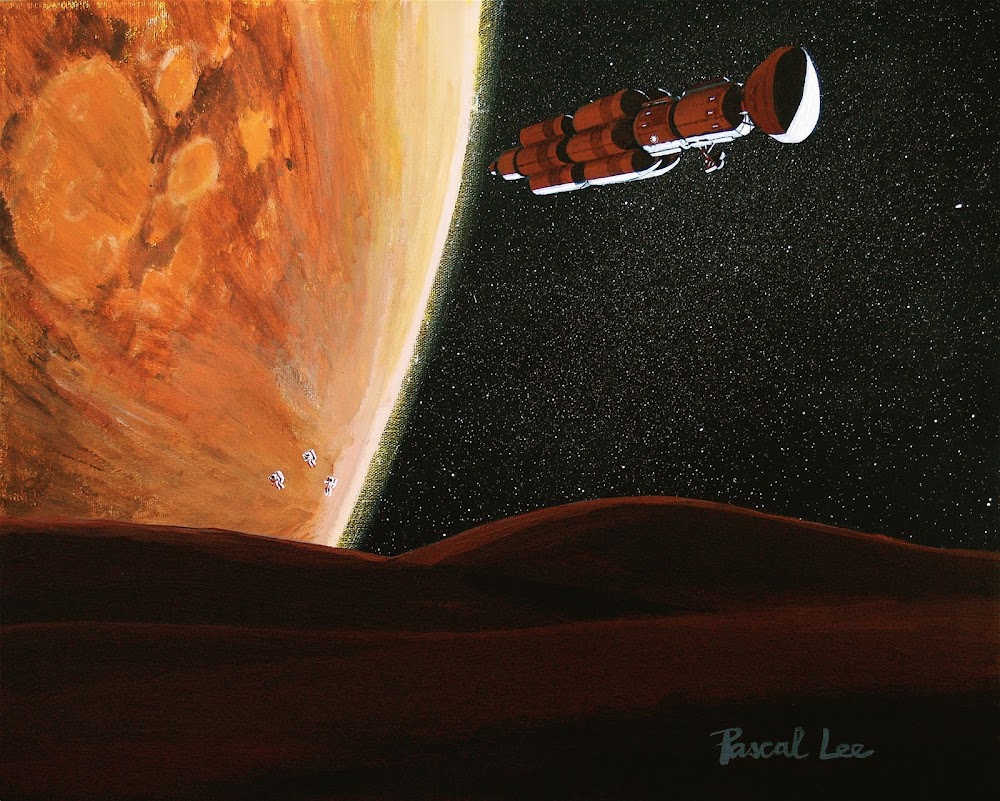A short animation with SpaceX's Starship & 6x6 Cybertruck at Mars Base Alpha by former avionics engineer, now CGI artist Slave Popovski (known as pslavi) from Australia.
Sunday, January 16, 2022
Sunday, January 9, 2022
New settlers arriving on Mars
New settlers arriving at Martian spaceport – a concept artwork by Canadian illustrator Alexandra Hodgson for upcoming computer game Terraformers. It's a Mars colonization strategy game to be released in Q1 2022 and developed by indie game developer Asteroid Lab. Since October 2021 you can play free prologue of the game.
Design of the spaceship is clearly inspired by the initial design of SpaceX's Starship when it was first presented in 2016 and called Interplanetary Transport System. As we have observed – that first 12m diameter Starship design is quite popular with artists and game developers depicting colonization of Mars.
Design of the spaceship is clearly inspired by the initial design of SpaceX's Starship when it was first presented in 2016 and called Interplanetary Transport System. As we have observed – that first 12m diameter Starship design is quite popular with artists and game developers depicting colonization of Mars.
Saturday, January 1, 2022
Mars base by Tetsuya Mizuno
Picture of the Day 01/01/2022 - a small shuttle landing at human base on Mars by Japanese illustrator Tetsuya Mizuno (Watermark).
Closeup of illustration's right side:
Friday, December 24, 2021
Merry Christmas from Santa Claus on Mars!
 Merry Christmas for you all from Santa Claus on Mars! Artwork by American illustrator, Star Wars artist Chris Trevas. More of his art here.
Merry Christmas for you all from Santa Claus on Mars! Artwork by American illustrator, Star Wars artist Chris Trevas. More of his art here.
Sunday, December 19, 2021
Map of shallow subsurface water in Valles Marineris on Mars
On December 15 scientists from Space Research Institute of the Russian Academy of Sciences in Moscow, Russia revealed a discovery of an area with an unusually large amount of hydrogen in the Valles Marineris canyon system on Mars. Assuming the hydrogen is bound into water molecules, as much as 40% of the near-surface material in Candor Chaos region appears to be water. The discovery was made by neutron detector FREND on ESA&Roscosmos's ExoMars Trace Gas Orbiter orbiting Mars since October 2016. FREND is mapping the distribution of hydrogen in the uppermost meter of the planet’s surface. Hydrogen indicates the presence of water, being one of the constituents of the water molecule; it can also indicate water absorbed into the surface, or minerals that were formed in the presence of water.
While water is known to exist on Mars, most is found in the planet’s cold polar regions as ice. Typically water ice is not found exposed at the surface near the equator, as temperatures there are not cold enough for exposed water ice to be stable. Minerals seen in this part of Mars typically contain only a few percent water, much less than is evidenced by these new observations. “We found a central part of Valles Marineris to be packed full of water – far more water than we expected. This is very much like Earth’s permafrost regions, where water ice permanently persists under dry soil because of the constant low temperatures,” told one of the scientists involved in the study.
These are very inspiring discoveries for the future human colonization of Valles Marineris region we have imagined in our speculative Mars Colonization Timeline!

⇧ In the area C up to 40% of the near-surface material appears to be composed of water (by weight).
HERE is global-scale map of shallow subsurface water distribution on Mars published in 2019.
While water is known to exist on Mars, most is found in the planet’s cold polar regions as ice. Typically water ice is not found exposed at the surface near the equator, as temperatures there are not cold enough for exposed water ice to be stable. Minerals seen in this part of Mars typically contain only a few percent water, much less than is evidenced by these new observations. “We found a central part of Valles Marineris to be packed full of water – far more water than we expected. This is very much like Earth’s permafrost regions, where water ice permanently persists under dry soil because of the constant low temperatures,” told one of the scientists involved in the study.
These are very inspiring discoveries for the future human colonization of Valles Marineris region we have imagined in our speculative Mars Colonization Timeline!

⇧ In the area C up to 40% of the near-surface material appears to be composed of water (by weight).
The most water-rich area in Valles Marineris region is located in Candor Chaos:
HERE is global-scale map of shallow subsurface water distribution on Mars published in 2019.
Friday, December 10, 2021
Lunar colony in season 5 of The Expanse
After the bombardment of Earth Lovell City on Luna (the Moon) became the de facto capital of United Nations, one of the three competing powers in universe of The Expanse TV series - a political sci-fi drama set a few centuries in the future where humans have colonized the entire Solar system. Luna functions as a way station between Earth and the rest of the Solar system, and its spaceport at Lovell City serves as a natural meeting place between residents of the inner planets and Belters. Due to its lower gravity, Luna is the only body in the inner system that Belters can easily visit. UN citizens living on Luna are generally wealthier than most of their counterparts on Earth.
As Mars was one of the major locations in season 4 of the show, Luna is in season 5, coming into spotlight after the bombardment of Earth. Here is a collection with HD images from the Lunar scenes in season 5 of The Expanse. There are a few more from the trailer of the season.
As Mars was one of the major locations in season 4 of the show, Luna is in season 5, coming into spotlight after the bombardment of Earth. Here is a collection with HD images from the Lunar scenes in season 5 of The Expanse. There are a few more from the trailer of the season.
Avasarala looking at Lovell City:
Memorial at Lovell City:
Monday, December 6, 2021
SpaceX Legacy: episode 1: Manned Mission to Mars
YouTuber iamVisual has started to produce animated short series about the legacy of SpaceX – the leading NewSpace company developing innovative and cost-effective rocket and space technologies, including the first fully and rapidly reusable rocket system – two-stage super heavy-lift Starship rocket. The 1st episode of the series visualizes first human mission to Mars. You can watch it here:
Sunday, November 28, 2021
Human mission to Martian moons Phobos and Deimos by Pascal Lee
 Over the years planetary scientist, the director of Haughton-Mars Project, Pascal Lee has created a set of paintings depicting human mission to the Martian moons Phobos and Deimos. Here are several of them. More of his Mars related paintings here.
Over the years planetary scientist, the director of Haughton-Mars Project, Pascal Lee has created a set of paintings depicting human mission to the Martian moons Phobos and Deimos. Here are several of them. More of his Mars related paintings here.
Spaceship approaching Mars with Phobos and Deimos in sight:
Landing on Deimos, the farthest and smallest of the two Martian moons:
Astronauts exploring Deimos:
Landing on Phobos, the closest and largest of the two Martian moons:
Thursday, November 25, 2021
SpaceX Starship next to SLS rolling out of NASA's VAB by James Vaughan
Picture of the Day 25/11/2021 - SpaceX's full stack Starship Super Heavy rolling out of NASA's Vehicle Assembly Building (VAB) next to Space Launch System (SLS) rocket at Kennedy Space Center by American photographer and concept artist James Vaughan. More of his aerospace and defense concept art here.
Saturday, November 20, 2021
Domed Martian city by Indranil Saha
 Picture of the Day 20/11/2021 - an early human base on Mars in front of a domed city (Gaia-1) by graphic designer Indranil Saha (known as encreate) from India. More of his art here.
Picture of the Day 20/11/2021 - an early human base on Mars in front of a domed city (Gaia-1) by graphic designer Indranil Saha (known as encreate) from India. More of his art here.
Subscribe to:
Posts (Atom)

